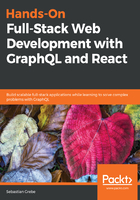
Rendering arrays from React state
Hello World! is a must for every good programming book, but this is not what we are aiming for when we use React.
A social network such as Facebook or Graphbook, which we are writing at the moment, needs a news feed and an input to post news. Let's implement this.
For the simplicity of the first chapter, we do this inside App.js.
We should work with some fake data here since we have not yet set up our GraphQL API. We can replace this later with real data.
Define a new variable above your App class like this:
const posts = [{
id: 2,
text: 'Lorem ipsum',
user: {
avatar: '/uploads/avatar1.png',
username: 'Test User'
}
},
{
id: 1,
text: 'Lorem ipsum',
user: {
avatar: '/uploads/avatar2.png',
username: 'Test User 2'
}
}];
We now render these two fake posts in React.
Replace the current content of your render method with the following code:
const { posts } = this.state;
return (
<div className="container">
<div className="feed">
{posts.map((post, i) =>
<div key={post.id} className="post">
<div className="header">
<img src={post.user.avatar} />
<h2>{post.user.username}</h2>
</div>
<p className="content">
{post.text}
</p>
</div>
)}
</div>
</div>
)
We iterate over the posts array with the map function, which again executes the inner callback function, passing each array item as a parameter one by one. The second parameter is just called i and represents the index of the array element we are processing. Everything returned from the map function is then rendered by React.
We merely return HTML by putting each post's data in ES6 curly braces. The curly braces tell React to interpret and evaluate the code inside them as JavaScript.
As you can see in the preceding code, we are extracting the posts we want to render from the component's state with a destructuring assignment. This data flow is very convenient because we can update the state at any point later in our application and the posts will rerender.
To get our posts into the state, we can define them inside our class with property initializers. Add this to the top of the App class:
state = {
posts: posts
}
The older way of implementing this—without using the ES6 feature—was to create a constructor:
constructor(props) {
super(props);
this.state = {
posts: posts
};
}
Upon initialization of the App class, the posts will be inserted into its state and rendered. It is vital that you run super before having access to this.
The preceding method is much cleaner, and I recommend this for readability purposes. When saving, you should be able to see rendered posts. They should look like this:

The images I am using here are freely available. You can use any other material that you have got, as long as the path matches the string from the posts array. You can find those images in the official GitHub repository of this book.